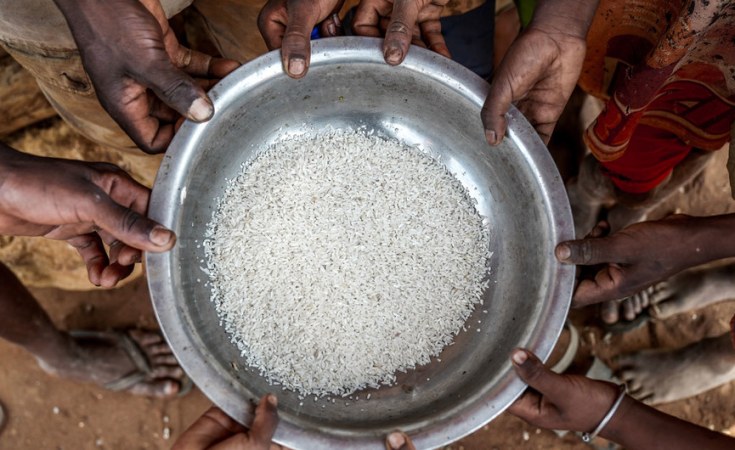Read in
By Nike Adebowale-Tambe
“Nigeria, Africa’s most populous nation previously ranked 103 out of 116 countries in 2021 and 98 among 107 countries in 2020.”
Nigeria has been ranked 103 out of 121 countries in the 2022 Global Hunger Index, a position that signifies the nation “has a level of hunger that is serious”.
The Global Hunger Index was jointly published by the German-based Welthungerhilfe and Dublin-based Concern Worldwide on Friday.
The report, which ranks countries by “severity”, gave Nigeria a score of 27.3 – a hunger level falling under the “serious” category.
The index has five levels of hunger under which each country falls – low, moderate, serious, alarming, and extremely alarming.
This is the second consecutive year in which Nigeria’s ranking on the scale remains the same. Nigeria, Africa’s most populous nation, ranked 103 out of 116 countries in 2021 and 98 among 107 countries in 2020.
GHI
The GHI is a tool for comprehensively measuring and tracking hunger at global, regional, and national levels. Its scores are based on the values of four component indicators: undernourishment, child stunting, child wasting, and child mortality.
The 2022 report indicates that 12.7 per cent of Nigeria’s population is undernourished. It also shows that 6.5 per cent of under-five children in the country are wasted while 31.5 per cent of children under five are stunted.
It also indicates that 11.4 per cent of children in Nigeria die before their fifth birthday.
Undernourishment measures the share of the population with insufficient caloric intake while child stunting analyses the share of children under five who have low height for their age, reflecting chronic undernutrition.
Child wasting signifies the share of children under five who have low weight for their height, reflecting acute undernutrition; child mortality on the other hand indicates the share of children who die before their fifth birthday, partly reflecting the fatal mix of inadequate nutrition and unhealthy environments.
Based on the values of the four indicators, a GHI score is calculated on a 100-point scale reflecting the severity of hunger, where 0 is the best possible score (no hunger) and 100 is the worst. Each country’s GHI score is classified by severity, from low to extremely alarming.
According to the report, 17 countries including China, Hungary, Montenegro, Uzbekistan, Russia and Saudi Arabia shared the top rank with a GHI score of less than 5.
No country has been placed in the extremely alarming category this year.
Global trends
According to the report, some 828 million people were affected by hunger globally in 2021, an increase of about 46 million people since 2020 and 150 million people since the outbreak of the COVID-19 pandemic.
The index indicates that the highest levels of hunger were in “Africa South of the Sahara” and South Asia – with progress against hunger in these regions having stagnated in recent years.
“The situation is likely to worsen in the face of the current barrage of overlapping global crises – conflict, climate change, and the economic fallout of the COVID-19 pandemic–all of which are powerful drivers of hunger,” the report said.
“The war in Ukraine has further increased global food, fuel, and fertilizer prices and has the potential to contribute to food shortages in 2023 and beyond.”
The report also forecasts that by 2030, there will still be hundreds of millions of people experiencing hunger thereby failing to meet set targets by the United Nations.
“While we may not be able to end hunger by then, we can stop it heading in the wrong direction,” Concerns’ head of advocacy, Réiseal Chéilleachair, said in a statement published on its website.
She said the number of shocks people are experiencing means more effort is needed to increase global food, nutrition, and livelihood security.
“The interdependency of the food system is evident in how shocks in one country can have a direct impact on the purchasing power and food consumption of families in another,” she said.
Nigeria’s reality
Nigeria’s position on the GHI is not news as previous reports had predicted a hunger crisis in Nigeria and its effect on the people, especially children.
A 2021 UNICEF report titled ‘Fed to Fail’, had revealed that many children under age two are lacking the food and nutrients they need to thrive and grow well, leading to irreversible developmental harm.
The report also indicates that nutritional intake in the first two years of life can harm children’s rapidly growing bodies and brains, impacting their futures.
“The findings of the report are clear: millions of young children are not being fed diets adequate for their growth and development,” UNICEF Nigeria Deputy Representative, Rushnan Murtaza, had said.
Another report by the United Nations Food and Agriculture Organisation in March predicted that about 19.4 million people will face food insecurity across Nigeria between June and August earlier this year.
The report also shows that about 14.4 million people including 385,000 IDPs in 21 states and Abuja were already in a food crisis at the time of the report.
Nigeria’s hunger crisis has majorly been attributed to the insecurity ravaging many parts of the country.
For more than a decade, Nigeria, and specifically the Northern region, has been subjected to relentless attacks by deadly groups such as Boko Haram and the Islamic State’s West Africa Province (ISWAP).
The violence has caused the death of thousands of people, wreaked havoc on agricultural output and other livelihoods, cut off crucial services, and caused the internal displacement of millions of people.
Researchers have said that unless Nigeria addresses and puts an end to its security challenges, more people will go hungry in years to come.
“It is critical to act now to rebuild food security on a new and lasting basis. Failure to do means sleepwalking into the catastrophic and systematic food crisis in the future,” Ms Chéilleachair said.



